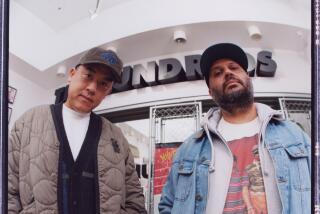Column: Is Urban Outfitters waving the bloody shirt?
It was the hand-me-down from hell: a Kent State University sweatshirt, faded, hole-filled and splattered with red dye — or was that blood? — offered online by Urban Outfitters last weekend for $129.
A scandal ensued — and not because of the price tag. Kent State, as you may remember (or have read about in history books), was the site of a historic massacre in 1970, when the National Guard shot 13 students, killing four, in the wake of campus political protests (though not all the victims were protesting). News of the sweatshirt made its way to Twitter over the weekend, at which point BuzzFeed got a screen grab of the listing and sent it on its viral way.
When the commentariat wasn’t dreaming up analogously tasteless items — the Trayvon Martin hoodie, the twin towers hologram dress — or bashing Urban Outfitters for exploiting a national tragedy in the pursuit of revenue and hipster cred, it was demanding answers: Who designed this shirt? How did it wend its way though the company’s various channels? Was this a cynical marketing ploy or just the result of some clueless young executive thinking that a faded Kent State sweatshirt with red splotches on it represented nothing more than a really cool look?
Considering the widespread indignation, it’s surprising that more people didn’t notice that the shirt was a single, used item, not mass produced with stains and holes. It had probably been floating around for years until an Urban Outfitters buyer spotted it. It was sold on the company’s “urban renewal” site, essentially an online flea market.
Admittedly, it’s impossible to know whether the splotches were there in the first place or put there after the fact. When I dug up a job listing for an Urban Outfitters “renewal buyer,” I noticed that buyers are supposed to “come up with creative ways to reinvent vintage apparel by utilizing dye techniques and applique treatment.” Amid the controversy, the company issued a statement saying that the red splotches were merely “discoloration from the original shade of the shirt.” And while that does suggest that the splotches are the product of an in-house arts and crafts project, there’s still no telling whether the utilizer of those dyeing techniques had enough knowledge of history to know what he or she was doing.
To many, it didn’t much matter. Urban Outfitters has a long history of selling items that cause publicity-generating opprobrium. And if that really is a deliberate strategy — if one ratty sweatshirt can cause a viral sensation — you have to admit it’s pretty effective. Everyone who ranted about the Kent State shirt on social media this week only made that strategy more effective.
In the end, though, I suspect the outrage isn’t really about this particular of piece of clothing but about current clothing attitudes in general — or at least one of those attitudes, which essentially says, “When I get dressed, I respect my freedom of expression more than I respect those around me.”
I’m not singling out any one fashion trend. I’m talking about sartorial choices that draw attention to the wearer while essentially saying that everyone else might as well be invisible. I’m talking about men with their pants hanging practically to their knees and women wearing sweatpants with “kiss my” written on the backside. I’m talking about airline passengers who wear T-shirts bearing curse words and then make a stink when they are asked to cover up the shirt or leave the plane. I’m talking about baby onesies that say, “I’m proof that my mom puts out” (I didn’t make that up).
I realize our forefathers fought for our freedom to dress as atrociously as we can get away with. But the collective effect of all this messaging is that the line between expressing oneself and provoking others has become blurred. Worse, provoking others is no longer considered rude or aberrant behavior. It’s commonplace. All day, every day, we are provoked — by clickbait news headlines, by racy billboards, by trashy attire for all ages. And since most of the time we’re powerless to do anything about it, we wage battles where we can, even if it’s over an old college sweatshirt someone noticed online.
Given the battle waged with it this week, that Kent State shirt must be even more worn and full of holes now. I bet it’s worth $229.
Twitter: @meghan_daum
More to Read
A cure for the common opinion
Get thought-provoking perspectives with our weekly newsletter.
You may occasionally receive promotional content from the Los Angeles Times.







